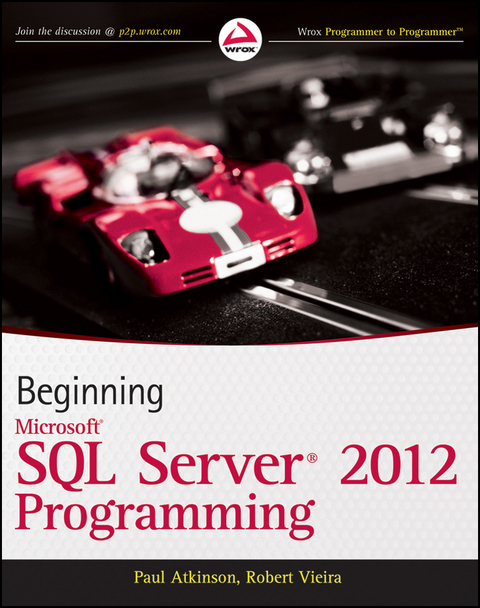Description
Efnisyfirlit
- Cover
- Contents
- Title page
- Copyright
- Dedication
- Credits
- About the Authors
- About the Technical Editor
- Acknowledgments
- Introduction
- 1 RDBMS Basics: What Makes Up a SQL Server Database?
- An Overview of Database Objects
- SQL Server Data Types
- SQL Server Identifiers for Objects
- Summary
- 2 Learning the Tools of the Trade
- Getting Help with Books Online
- SQL Server Configuration Manager
- SQL Server Management Studio
- SQL Server Data Tools (formerly BIDS)
- SQL Server Integration Services (SSIS)
- SQL Server Reporting Services (SSRS)
- SQL Server Analysis Services (SSAS)
- Bulk Copy Program (BCP)
- SQL Server Profiler
- sqlcmd
- PowerShell
- Summary
- 3 The Foundation Statements of T-SQL
- Getting Started with a Basic SELECT Statement
- Adding Data with the INSERT Statement
- Changing What You’ve Got with the UPDATE Statement
- The DELETE Statement
- Summary
- 4 Joins
- Combining Table Data with JOINs
- Selecting Matching Rows with INNER JOIN
- Retrieving More Data with OUTER JOIN
- Seeing Both Sides with FULL JOINs
- Understanding CROSS JOINs
- Exploring Alternative Syntax for Joins
- Stacking Results with UNION
- Summary
- 5 Creating and Altering Tables
- Object Names in SQL Server
- The CREATE Statement
- The ALTER Statement
- The DROP Statement
- Using the GUI Tool
- Summary
- 6 Keys and Constraints
- Types of Constraints
- Constraint Naming
- Key Constraints
- CHECK Constraints
- DEFAULT Constraints
- Disabling Constraints
- Rules and Defaults — Cousins of Constraints
- Triggers for Data Integrity
- Choosing What to Use
- Summary
- 7 Adding More to Your Queries
- What Is a Subquery?
- Building Correlated Subqueries
- Derived Tables
- Using Common Table Expressions (CTEs)
- Using the EXISTS Operator
- Mixing Data Types: CAST and CONVERT
- Synchronizing Data with the MERGE Command
- Gathering Affected Rows with the OUTPUT Clause
- Through the Looking Glass: Windowing Functions
- One Chunk at a Time: Ad Hoc Query Paging
- Performance Considerations
- Summary
- 8 Being Normal: Normalization and Other Basic Design Issues
- Understanding Tables
- Keeping Your Data “Normal”
- Understanding Relationships
- Diagramming Databases
- Denormalization
- Beyond Normalization
- Drawing Up a Quick Example
- Summary
- 9 SQL Server Storage and Index Structures
- SQL Server Storage
- Understanding Indexes
- Creating, Altering, and Dropping Indexes
- Choosing Wisely: Deciding Which Index Goes Where and When
- Maintaining Your Indexes
- Summary
- 10 Views
- Creating Simple Views
- Editing Views with T-SQL
- Dropping Views
- Creating and Editing Views in the Management Studio
- Auditing: Displaying Existing Code
- Protecting Code: Encrypting Views
- About Schema Binding
- Making Your View Look Like a Table with VIEW_METADATA
- Indexed (Materialized) Views
- Indexing an Aggregate View
- Summary
- 11 Writing Scripts and Batches
- Understanding Script Basics
- Grouping Statements into Batches
- Running from the Command Prompt: sqlcmd
- Dynamic SQL: Using the EXEC Command
- Using Control-of-Flow Statements
- Summary
- 12 Stored Procedures
- Creating the Sproc: Basic Syntax
- Changing Stored Procedures with ALTER
- Dropping Sprocs
- Parameterizing Sprocs
- More on Dealing with Errors
- What a Sproc Offers
- Extended Stored Procedures (XPs)
- A Brief Look at Recursion
- Debugging
- Understanding .NET Assemblies
- When to Use Stored Procedures
- Summary
- 13 User-Defined Functions
- What a UDF Is
- UDFs Returning a Scalar Value
- UDFs That Return a Table
- Debugging User-Defined Functions
- Using .NET in a Database World
- Summary
- 14 Transactions and Locks
- Understanding Transactions
- How the SQL Server Log Works
- Understanding Locks and Concurrency
- Setting the Isolation Level
- Dealing with Deadlocks (aka “a 1205”)
- Summary
- 15 Triggers
- What Is a Trigger?
- Using Triggers for Data Integrity Rules
- Other Common Uses for Triggers
- Other Trigger Issues
- Instead of Triggers
- Performance Considerations
- Dropping Triggers
- Debugging Triggers
- Summary
- 16 A Brief XML Primer
- XML Basics
- What SQL Server Brings to the Party
- A Brief Word on XSLT
- Summary
- 17 Business Intelligence Fundamentals
- What Is Business Intelligence?
- Those Who Forget History: The Data Warehouse
- Dimensional Modeling: Why Be Normal?
- ETLs
- Making Your Data Actionable: BI Reporting Techniques
- Summary
- 18 BI Storage and Reporting Resources
- BI in T-SQL
- SQL Server Analysis Services, or How I Learned to Stop Worrying and Love the Cube
- Building Your First Cube
- Self-Service BI: User Tools
- Summary
- 19 Reporting for Duty, Sir! A Look at Reporting Services
- Reporting Services 101
- Understanding the SSRS Report Lifecycle
- Understanding the Reporting Services Architecture
- Building Simple Report Models
- Report Server Projects
- Summary
- 20 Getting Integrated with Integration Services
- Understanding the Problem
- Using the Import/Export Wizard to Generate Basic Packages
- Examining Package Basics
- Executing Packages
- A Final Word on Packages
- Summary
- 21 Playing Administrator
- Scheduling Jobs
- Logins and Users
- Backup and Recovery
- Index Maintenance
- Policy Based Management
- Automating Administration Tasks with PowerShell
- Summary
- Appendix: Answers to Exercises
- Bonus Appendices
- Bonus Appendix 1: System Functions
- System Statistical Functions
- Aggregate Functions
- Analytic Functions
- Configuration Functions
- Conversion Functions
- Cryptographic Functions
- Cursor Functions
- Date and Time Functions
- Hierarchy Functions
- Mathematical Functions
- Basic Metadata Functions
- Ranking Functions
- Rowset Functions
- Security Functions
- String Functions
- System Functions
- Text and Image Functions
- Bonus Appendix 2: Very Simple Connectivity Examples
- Some General Concepts
- Connectivity Examples
- A Brief Word on LINQ
- Advertisement
- End User License Agreement






Reviews
There are no reviews yet.